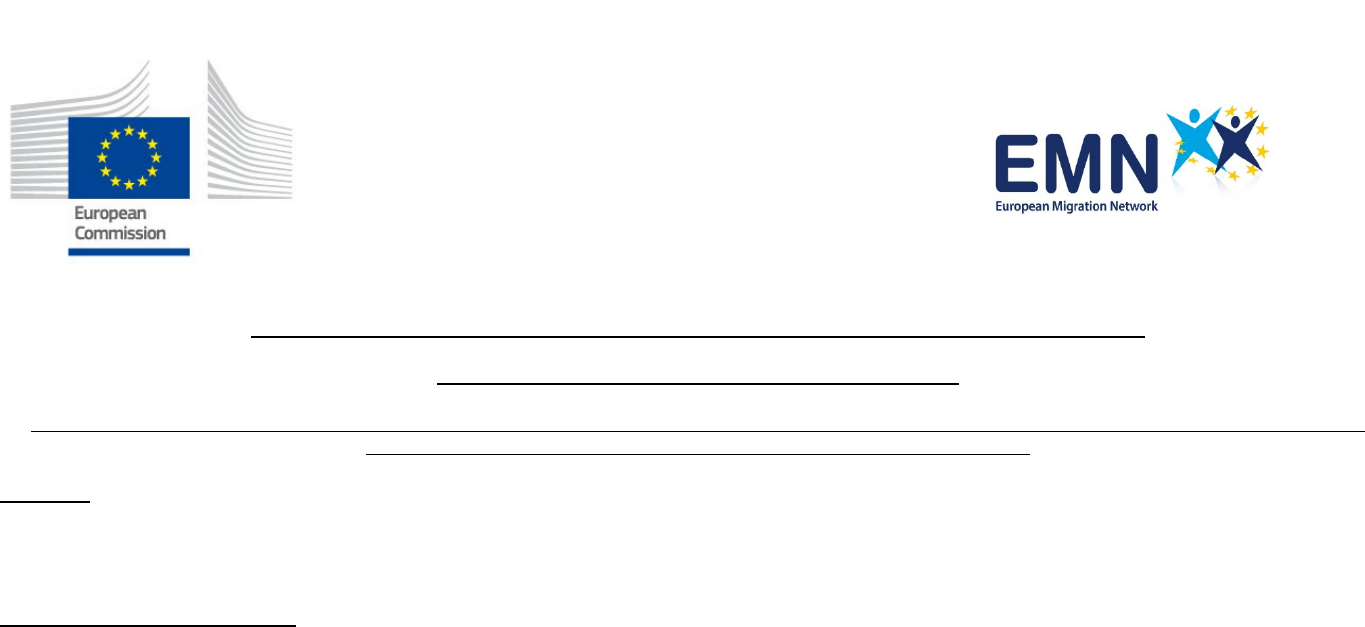
1 of 29.
AD HOC QUERY ON 2021.10 Unaccompanied minors - age assessment methods used by Member States
Requested by EMN NCP Czech Republic on 18 February 2021
Responses from Austria, Bulgaria, Croatia, Cyprus, Czech Republic, Estonia, Finland, France, Germany, Hungary, Ireland, Italy, Latvia, Lithuania, Luxembourg,
Netherlands, Poland, Portugal, Slovakia, Slovenia, Spain, Sweden (22 in Total)
Disclaimer:
The following responses have been provided primarily for the purpose of information exchange among EMN NCPs in the framework of the EMN. The contributing EMN
NCPs have provided, to the best of their knowledge, information that is up-to-date, objective and reliable. Note, however, that the information provided does not
necessarily represent the official policy of an EMN NCPs' Member State.
1. Background information
The Czech Republic would like to kindly ask other EU Member States which methods they use in a case of unaccompanied “minors” (hereinafter UAM) when it is
necessary to determine their age as we did not gather all necessary information form EMN recent materials. The question targets at different categories of UAMs, be
them irregular migrants, asylum seekers etc.
In a case of doubts about the age of the foreigner (whether he/she is an adult or UAM), an anthropological medical examination is used to determine his/her approximate
calendar age, specifically the X-ray skeleton of the hand (wrist), in the Czech Republic.
As for the specific methods of this bone age assessment, the medical facilities addressed by the Ministry of the Interior (Police of the Czech Republic) use the TW3
method (Tanner-Whitehouse 3) and the GP method (Greulich-Pyle), respectively.

AD HOC QUERY ON 2021.10 Unaccompanied minors - age assessment methods used by Member States
Disclaimer:
The following responses have been provided primarily for the purpose of information exchange among EMN NCPs in the framework of the EMN. The contributing EMN NCPs have provided, to the
best of their knowledge, information that is up-to-date, objective and reliable. Note, however, that the information provided does not necessarily represent the official policy of an EMN NCPs'
Member State.
2 of 29.
An important part of the whole process of determining the age of an unaccompanied minor is also the discretion of the administrative body itself, as to whether there
are doubts about the stated age and the evaluation of all available information so that it is as holistic as possible to determine the age of the foreigner stating that
he/she is a UAM or not.
However, Police of the Czech Republic is now evaluating possibly less invasive methods of age assessment. Thus, we would be grateful for examples of practice in other
EU Members States in this regard.
2. Questions
1. Which methods are used for the age assessment in your country, when it is necessary to determine whether the foreigner is an UAM or an adult? Please list all
of them, be it medical methods (e.g. X-ray), non-medical (e.g. psychological interview) or combination of both of them.
2. If the combination of methods is used, what is the chronological order – i.e. which method is used first and which follows?
3. What is the procedure in these cases – which institution requests the age assessment and which institution performs it?
We would very much appreciate your responses by 18 March 2021.
3. Responses
1
1
If possible at time of making the request, the Requesting EMN NCP should add their response(s) to the query. Otherwise, this should be done at the time of making the compilation.

AD HOC QUERY ON 2021.10 Unaccompanied minors - age assessment methods used by Member States
Disclaimer:
The following responses have been provided primarily for the purpose of information exchange among EMN NCPs in the framework of the EMN. The contributing EMN NCPs have provided, to the
best of their knowledge, information that is up-to-date, objective and reliable. Note, however, that the information provided does not necessarily represent the official policy of an EMN NCPs'
Member State.
3 of 29.
Wider
Dissemination
2
EMN NCP
Austria
Yes
1. In Austria, both in asylum proceedings and in proceedings under the Settlement and
Residence Act, unobjectionable documents or other suitable and equivalent means of
attestation are initially considered to prove the applicant’s alleged minority that is
doubtful on the basis of the investigation results available. If this verification does not
succeed, radiological examinations, in particular X-ray examinations, can be arranged as
part of a multifactorial examination method for age assessment. According to Art. 2 para
1 subpara 25 Asylum Act 2005, the multifactorial examination methodology is a model
for determining age based on three individual medical examinations (in particular
physical, dental and X-ray examinations) based on current scientific knowledge. Each
examination method must be carried out with the least possible interference, and the
person in question cannot be coerced into participating in a radiological examination. If
there are still valid doubts after the age assessment, it must be assumed in favor of the
person concerned that he or she is a minor (Art. 13 para 3 Federal Office for Immigration
and Asylum Procedures Act, Art. 29 para 4 Settlement and Residence Act).In Austria, both
in asylum proceedings and in proceedings under the Settlement and Residence Act,
unobjectionable documents or other suitable and equivalent means of attestation are
initially considered to prove the applicant’s alleged minority that is doubtful on the basis
of the investigation results available. If this verification does not succeed, radiological
examinations, in particular X-ray examinations, can be arranged as part of a multifactorial
2
A default "Yes" is given for your response to be circulated further (e.g. to other EMN NCPs and their national network members). A "No" should be added here if you do not wish your
response to be disseminated beyond other EMN NCPs. In case of "No" and wider dissemination beyond other EMN NCPs, then for the Compilation for Wider Dissemination the response
should be removed and the following statement should be added in the relevant response box: "This EMN NCP has provided a response to the requesting EMN NCP. However, they have
requested that it is not disseminated further."

AD HOC QUERY ON 2021.10 Unaccompanied minors - age assessment methods used by Member States
Disclaimer:
The following responses have been provided primarily for the purpose of information exchange among EMN NCPs in the framework of the EMN. The contributing EMN NCPs have provided, to the
best of their knowledge, information that is up-to-date, objective and reliable. Note, however, that the information provided does not necessarily represent the official policy of an EMN NCPs'
Member State.
4 of 29.
examination method for age assessment. According to Art. 2 para 1 subpara 25 Asylum
Act 2005, the multifactorial examination methodology is a model for determining age
based on three individual medical examinations (in particular physical, dental and X-ray
examinations) based on current scientific knowledge. Each examination method must be
carried out with the least possible interference, and the person in question cannot be
coerced into participating in a radiological examination. If there are still valid doubts after
the age assessment, it must be assumed in favor of the person concerned that he or she
is a minor (Art. 13 para 3 Federal Office for Immigration and Asylum Procedures Act, Art.
29 para 4 Settlement and Residence Act).
2.
See answer to question 1.
3. Whether a medical age assessment is carried out is generally at the discretion of the
authority (see Art 13 para 3 Federal Office for Immigration and Asylum Procedures Act,
Art. 29 para 4 Settlement and Residence Act and EMN study "The Establishment of
Identity in the Austrian Migration Process", 2017, p. 54). The age assessment in the
asylum procedure is requested by the Federal Office for Immigration and Asylum or the
Federal Administrative Court. Within the scope of application of the Settlement and
Residence Act, the age assessment is requested by the responsible settlement authority.
According to the case law of the Supreme Administrative Court, an age assessment
usually requires an examination and assessment by suitable (mostly medical) experts
(Supreme Administrative Court, 16.4.2007, 2005/01/0463).
EMN NCP
Bulgaria
Yes
1. X-ray diagnostics is used in the Republic of Bulgaria. It is applied to the wrist, knee or
hip joint. The radiography can be performed in different projection.

AD HOC QUERY ON 2021.10 Unaccompanied minors - age assessment methods used by Member States
Disclaimer:
The following responses have been provided primarily for the purpose of information exchange among EMN NCPs in the framework of the EMN. The contributing EMN NCPs have provided, to the
best of their knowledge, information that is up-to-date, objective and reliable. Note, however, that the information provided does not necessarily represent the official policy of an EMN NCPs'
Member State.
5 of 29.
2. N/A
3.
The institution that makes the request for age assessment is the Migration Directorate.
The institution that performs the age assessment is the Medical Institute of the Ministry
of Interior.
EMN NCP
Croatia
Yes
1. When unaccompanied minors have their identification documents it is necessary to
determine if they are credible or not. Unaccompanied minors usually do not have
documents that could confirm their identity so the primary assessment is carried out on
the basis of the opinion and observations of experts involved in working with the minor in
particular, by assessing the communication, reaction, and behavior of the child in relation
to the stated age, as well as the understanding and description of events and experiences,
social relations and circumstances, physical appearance and other available information
about the UAM.
It should be emphasized that in practice, when dealing with minors, each juvenile is
approached individually, respecting the principle of the best interests of the child. This
would mean that the assessment of age will initially be approached through milder
measures, i.e. an approximate assessment of age will be made in terms of assessing
whether it is an adult or a minor based on expert observations, which is further regulated
by the Protocol on Unaccompanied Children, and only subsequently if such an assessment
is not possible, or there are indications that such an assessment will not be credible,
medical experts will be approached.

AD HOC QUERY ON 2021.10 Unaccompanied minors - age assessment methods used by Member States
Disclaimer:
The following responses have been provided primarily for the purpose of information exchange among EMN NCPs in the framework of the EMN. The contributing EMN NCPs have provided, to the
best of their knowledge, information that is up-to-date, objective and reliable. Note, however, that the information provided does not necessarily represent the official policy of an EMN NCPs'
Member State.
6 of 29.
In the Republic of Croatia, in accordance with the Protocol on the treatment of
unaccompanied children, doubt concerning the age of the UAM may be expressed by a
police officer, special guardian, doctor, reception officer. The primary assessment is
carried out on the basis of the opinion and observations of experts involved in working
with the minor in particular, by assessing the communication, reaction, and behavior of
the child in relation to the stated age, as well as the understanding and description of
events and experiences, social relations and circumstances, physical appearance and other
available information about the UAM.
Concerning the UAMs who are international protection applicants, it is foreseen by the Act
on International and Temporary Protection (OG 70/15. 127/17) that the assessment of the
minor's age shall be conducted on the basis of the information available on the minor,
including the expert opinions of persons involved in work with children. The medical
examination shall be conducted by means of a physical examination, X-ray of the teeth
and/or hands, with full respect for the dignity of the UAM.
With regards to irregular UAMs in the return procedure, it is foreseen by the Foreigners Act
(OG 133/20) that the assessment of age shall be carried out by collecting available data
on the minor and issuing an expert opinion, and if the available data are not sufficient, a
medical examination shall be performed by doctors implementing medical examination; X-
ray of teeth, and/or hands, with full respect for the dignity of UAMs. It is recommended to
carry out the assessment no later than eight days after the placement of the
unaccompanied child in a particular institution. If it is not possible to determine whether
the person is of age, the person will continue to be considered a minor.
2. Concerning the UAMs who are international protection applicants and are subjected to
the procedure of age assessment, the assessment shall be primarily conducted on the
basis of the information available on the minor, including the expert opinions of persons

AD HOC QUERY ON 2021.10 Unaccompanied minors - age assessment methods used by Member States
Disclaimer:
The following responses have been provided primarily for the purpose of information exchange among EMN NCPs in the framework of the EMN. The contributing EMN NCPs have provided, to the
best of their knowledge, information that is up-to-date, objective and reliable. Note, however, that the information provided does not necessarily represent the official policy of an EMN NCPs'
Member State.
7 of 29.
involved in work with children. Only if the information available is insufficient, a medical
examination shall be conducted, with the prior written consent of the minor and the
appointed special guardian.
It is also foreseen by the Foreigners Act that if the age of the UAM TCN is uncertain during
the decision-making process regarding the return, the age assessment procedure will be
initiated. The assessment of age in the return procedure shall be carried out by collecting
available data on the minor and issuing an expert opinion, and if the available data are
not sufficient, a medical examination may be conducted with the prior written consent of
the minor and the special guardian.
In each case, a UAM shall be informed in writing (in a language presumed UAM to
understand and in which is able to communicate) about the manner of examination and
its possible consequences for UAM’s health, the consequences of the results of the
medical examination for application, as well as the consequences of the unjustified
refusal of consent. During the medical examination, a UAM who does not understand
Croatian shall be provided with a translator/interpreter for a language which may be
reasonably presumed UAM can understand and in which is able to communicate.
3. In the national Protocol for proceeding towards UAMs the observations regarding the
age assessment were categorized in possible situations and/or phases of the procedure A)
if reasonable doubts regarding the stated age during the identification process exist, B) if
reasonable doubts regarding the age during the initial health examination exist C) if
reasonable doubts while the UAM is accommodated with the social service provider exist,
or D) if the reasonable doubts during the procedure for international protection exist. In
each of these categories, the administrative procedures and proceedings of the listed
official persons involved in the phase in question are elaborated further and specified with
regards to their competence. By comparing procedures in these categories, it is evident

AD HOC QUERY ON 2021.10 Unaccompanied minors - age assessment methods used by Member States
Disclaimer:
The following responses have been provided primarily for the purpose of information exchange among EMN NCPs in the framework of the EMN. The contributing EMN NCPs have provided, to the
best of their knowledge, information that is up-to-date, objective and reliable. Note, however, that the information provided does not necessarily represent the official policy of an EMN NCPs'
Member State.
8 of 29.
that the special guardians work closely with the officials of the Ministry of the Interior,
and one is obliged to inform the other officials of the existence of the reasonable doubt
according to the prescribed procedures.
In conclusion, the observations regarding the age assessment can be made starting from
the identification phase in the PA/PS, and if the obtained opinions of experts and the
collected data give rise to reasonable doubts about the age of the person posing as a
minor, the Ministry of the Interior will request medical examination from the Institute for
Forensic Medicine and Criminology (with the prior written consent of the UAM and special
guardian). The results of the medical examination are submitted to the Ministry of the
Interior and the special guardian and are taken into consideration during future
administrative proceedings. In the event of unjustified denial of consent, an
unaccompanied child will be considered an adult. The medical examination is conducted
for a period of two days, and the finding is concluded within fourteen days.
EMN NCP
Cyprus
Yes
1. Cyprus Asylum Service use non-medical and medical methods. The non -medical
methods are 1) applicants available documents, 2) reports of Social Welfare Services
(SWS) and 3) an age assessment interview conducted by the Asylum Service Officer. In
case, after the use of the non-medical methods, there are still doubts about the age, then,
we refer the applicant to proceed for medical examinations. These are panoramic x-ray,
wrist x-ray and dental examination.
2. In the majority of the cases, the report of the Social Welfare Services (SWS) comes first,
and then an age assessment interview is conducted. In case there is a need to further
examine the age we refer to medical examinations (a consent is needed before the

AD HOC QUERY ON 2021.10 Unaccompanied minors - age assessment methods used by Member States
Disclaimer:
The following responses have been provided primarily for the purpose of information exchange among EMN NCPs in the framework of the EMN. The contributing EMN NCPs have provided, to the
best of their knowledge, information that is up-to-date, objective and reliable. Note, however, that the information provided does not necessarily represent the official policy of an EMN NCPs'
Member State.
9 of 29.
referral and information concerning the procedure and possible consequences is given to
the applicant). The medical methods are applied when doubts still exists.
3. The report of the Social Welfare Services (SWS) is sent to the Asylum Service, which
conducts the age assessment interview. After the age assessment interview is done and if
doubts still exists, the Asylum Service sends a request to the Medical Services for the use
of medical examinations. The medical results are sent back to the Asylum Service for the
final assessment.
EMN NCP
Czech
Republic
Yes
1. An anthropological medical examination is used to determine his/her approximate
calendar age, specifically the X-ray skeleton of the hand (wrist).
2. N/A
3. As for the specific methods of this bone age assessment, the medical facilities
addressed by the Ministry of the Interior (Police of the Czech Republic) use the TW3
method (Tanner-Whitehouse 3) and the GP method (Greulich-Pyle), respectively.
EMN NCP
Estonia
Yes
1. The primary decision on the minor’s age is made on the basis of the data, documents
and statements provided by the minor. Child-sensitive age assessment interviews are
conducted as well to collect details on a minor’s background, identity, and possible
possession of documents.
According to Article 121 of the Obligation to Leave and Prohibition on Entry Act, if a
reasonable doubt arises about the correctness of the data submitted about the age of the
minor, medical examination may be carried out. This is done with the consent of the minor

AD HOC QUERY ON 2021.10 Unaccompanied minors - age assessment methods used by Member States
Disclaimer:
The following responses have been provided primarily for the purpose of information exchange among EMN NCPs in the framework of the EMN. The contributing EMN NCPs have provided, to the
best of their knowledge, information that is up-to-date, objective and reliable. Note, however, that the information provided does not necessarily represent the official policy of an EMN NCPs'
Member State.
10 of 29.
and his/her representative (for UAM it is the representative of the local municipality in
which the minor is staying). The medical examination will be carried out in the form of x-
ray of a wrist.
2. 1. Child-sensitive age assessment interview
2. X-ray of a wrist
3. The age assessment is required by the Police and Border Guard Board and performed
by the Estonian Forensic Science Institute.
EMN NCP
Finland
Yes
1. Finland utilizes medical methods to determine the age of the applicant. Most used
medical methods include carpal x-rays and panoramic dental radiographs. In rare cases
periapical dental x-rays are used as well. Psychological interviews are not utilized in
Finland as part of the age assessment procedure.
The medical methods are not 100 % accurate, but forensic odontologists and specialists
consider dental development as the most suitable way to assess age, since dental
development is least affected by sickness or deficiencies in nutrition. Reasons for
choosing the above-mentioned methods relate to the accuracy of dental radiographs and
the amount of x-rays (small) the applicant is subjected to. Dental radiographs can also be
used, afterwards, in dental care.
2. Forensic odontologists choose the most suitable method after an initial interview of the
applicant. During the interview the odontologist determines the applicant’s prior
circumstances such as nutrition and possible individual factors that may prevent the
process of age assessment. Equally, their height, and weight are measured. Followingly,
the most suitable medical method is applied. Age assessment is usually conducted as part

AD HOC QUERY ON 2021.10 Unaccompanied minors - age assessment methods used by Member States
Disclaimer:
The following responses have been provided primarily for the purpose of information exchange among EMN NCPs in the framework of the EMN. The contributing EMN NCPs have provided, to the
best of their knowledge, information that is up-to-date, objective and reliable. Note, however, that the information provided does not necessarily represent the official policy of an EMN NCPs'
Member State.
11 of 29.
of the applicant’s asylum process as the need for the age assessment is most often
identified by the interviewer during the asylum interview.
The final assessment concerning the applicants age is reached by an overall consideration
of the information provided by the applicant and the results of the medical age
assessment.
3. The age assessment is requested by the Finnish Immigration Service. According to the
Finnish Alien’s Act, section 6b a medical assessment is then carried out by the National
Institute for Health and Welfare at the request of the Finnish Immigration Service. Two
experts draw up a joint statement on the assessment. At least one of the experts shall be
an employee of the National Institute for Health and Welfare. An expert may be an
approved medical practitioner or an approved dentist with the necessary competence.
Actions required for the assessment may also, at the request of the National Institute for
Health and Welfare, be performed by central hospitals, municipal health centres or private
healthcare units.
EMN NCP
France
Yes
1. The assessment is made to ensure the minority of the person and the isolation from
the family on the French territory.
Pursuant to the decree of 20 November 2019 related to the assessment process for persons
who declare themselves as minor and temporarily or definitely with no protection from their
family, the age assessment is realized during an interview based on a range of indicators
that may include:
• Information provided to the President of the Departmental council by the
representative of the State in the department, in accordance with the procedures

AD HOC QUERY ON 2021.10 Unaccompanied minors - age assessment methods used by Member States
Disclaimer:
The following responses have been provided primarily for the purpose of information exchange among EMN NCPs in the framework of the EMN. The contributing EMN NCPs have provided, to the
best of their knowledge, information that is up-to-date, objective and reliable. Note, however, that the information provided does not necessarily represent the official policy of an EMN NCPs'
Member State.
12 of 29.
laid down in article 221-11 of the Code of Social Actions and Families, and article
3 of the decree of 20 Nov 2019
• A social assessment based on interviews conducted in line with the procedures set
out in article 4 and 9 of the present decree;
• Complementary medical examinations provided for in article 388 of the Civil Code,
in accordance with the conditions and the procedure set out in the same article:
article 388 of the Civil Code states that radiological bone examinations may be
carried out to assess someone’s age “in the absence of valid identity documents
and when the alleged age appears to be implausible. They may only be conducted
pursuant to a decision by the judicial authorities and with the consent of the
person concerned. […] The conclusions of such examinations, which must specify
the margin of error, may not be used on their own as a basis for determining
whether the person is a minor. In the event of doubt, it is always in favor of the
person concerned.” Moreover, this article specifies that “if there is any doubt
regarding the minority of the person, no assessment of his or her age may be
performed on the basis of an examination of the pubertal development of primary
and secondary sexual characteristics.”
The age assessment procedure thus starts with a social evaluation. The president of the
Departmental council may ask to a representative of the State in the department to provide
him with information relevant to determining the identity and the social situation of the
person, as well as to verify the authenticity of his or her identity documents. As a last resort,
these investigations may be medical, in the absence of valid identity documents and in
cases where the alleged age appears to be implausible.
Besides, medical examinations are strictly monitored, as any remaining doubt is always in
favor of the person concerned.
2. See Q1.

AD HOC QUERY ON 2021.10 Unaccompanied minors - age assessment methods used by Member States
Disclaimer:
The following responses have been provided primarily for the purpose of information exchange among EMN NCPs in the framework of the EMN. The contributing EMN NCPs have provided, to the
best of their knowledge, information that is up-to-date, objective and reliable. Note, however, that the information provided does not necessarily represent the official policy of an EMN NCPs'
Member State.
13 of 29.
3. Article 2 of the decree of 20 November 2019 states that the President of the
Departmental council where a person presents as an unaccompanied minor is responsible
for the assessment evaluation aimed to ensure the minority of the person and the
isolation from the family on the French territory. The social assessment of age is carried
out either by the services of the Departmental council or any organization from the public
or non-profit sector which this mission is delegated to (Article 4 of the decree of 20
November 2019). Since December 2019, the assessment procedure that is conducted as a
last resort follows the provisions of a “guide of good practices for the assessment of the
minority and the isolation of the people presenting as minors and deprived temporarily or
definitely from the protection of their family”. The guide was elaborated within the
framework of a multi-partners working group, supported by the French Ministry of Justice,
the Ministry for Solidarities and Health, the Ministry of the Interior, and the Ministry for
Territorial Cohesion and Relations with Local Government, and set out to harmonize the
evaluation practices of the professionals trained in conducting age assessment.
Radiological bone examinations can only be carried out pursuant to a decision by the
judicial authorities, upon the request of the Departmental council, and with the consent of
the person concerned (Article 388 of the Civil Code). These examinations must be
conducted in a forensic unit (Annex 1 of the interministerial circular of 25 January 2016).
EMN NCP
Germany
Yes
1. Sec. 42f Social Code provides the basis for the age determination process which
introduces a gradual procedure:
1. Check of personal documents, search for additional information;
2. Interview (two qualified, experienced staff members), overall impression of
development incl. qualified visual inspection;
3. In case of doubts: medical examination, method with lowest impact on the child’s
health;

AD HOC QUERY ON 2021.10 Unaccompanied minors - age assessment methods used by Member States
Disclaimer:
The following responses have been provided primarily for the purpose of information exchange among EMN NCPs in the framework of the EMN. The contributing EMN NCPs have provided, to the
best of their knowledge, information that is up-to-date, objective and reliable. Note, however, that the information provided does not necessarily represent the official policy of an EMN NCPs'
Member State.
14 of 29.
The Working Group of the Federal Youth Welfare Services advices to consult for the age
determination process the recommendations of the Working Group on Forensic Age
Diagnostic (Arbeitsgemeinschaft für Forensische Altersdiagnostik, AGFAD):
Psychological interview/tests
Dental observation
Physical development assessment; including sexual maturity observation - only visual
Knee x-ray - possible according to the AGFAD-guidelines
Carpal (hand/wrist) x-ray - possible according to the AGFAD-guidelines
Collar bone x-ray - possible according to the AGFAD-guidelines
Dental x-ray (Wisdom/front teeth) - possible according to the AGFAD-guidelines
Magnetic Resonance - possible according to the AGFAD-guidelines
2. Please see Q 1: Means and methods with the lowest impact first are following a holistic
approach and are only used if necessary to sufficiently determine the minimum age.
3. Age determination is relevant
a. in the process of taking into care of an unaccompanied minor (authority: Youth Welfare
Service, family court),
b. in certain cases, on occasion of unaccompanied minors on entry to the country
(authority: i.e. Border Police),
in cases of doubts about the age, occurring during the asylum process (authority: at first
hand – Youth Welfare Service/family court; in certain cases, also the Federal Office for
Migration and Refugees)
c. in cases of criminal proceedings (police, court).
In any case, medical examinations are carried out by medical specialists.

AD HOC QUERY ON 2021.10 Unaccompanied minors - age assessment methods used by Member States
Disclaimer:
The following responses have been provided primarily for the purpose of information exchange among EMN NCPs in the framework of the EMN. The contributing EMN NCPs have provided, to the
best of their knowledge, information that is up-to-date, objective and reliable. Note, however, that the information provided does not necessarily represent the official policy of an EMN NCPs'
Member State.
15 of 29.
EMN NCP
Hungary
Yes
1. In case the applicant claims himself to be a minor at any stage of the asylum
procedure and there is doubt about the age of the applicant, a doctor examines the age of
the applicant. If the applicant does not accept the result of the examination, (s)he may
request an examination by a medical expert.
If there is doubt about the age of the applicant based on the physical characteristics of
the applicant or the experiences of the personal interview, the asylum officer may also
initiate an examination by a medical expert. In some cases the child protection institution
can also warn the asylum authority that there is doubt about the age of the applicant.
During the age assessment process regarding a doctor’s examination as well as a medical
expert’s examination of the applicant, information is given to the applicant on the
consequences of the result. For examination by a medical expert the consent of the
applicant is needed. (S)he is also informed on the consequences of the denial of the
consent. Examinations by a medical expert are carried out by professional medical experts
with many years of experience in the field of age assessment.
The applicant has the right to refuse to undergo an examination by a medical expert in
case of all methods.
2. The asylum authority uses examinations by a medical expert.
3. The asylum authority requests the age assessment and the Hungarian Institute for
Forensic Sciences performs it.
EMN NCP
Ireland
No
This EMN NCP has provided a response to the requesting EMN NCP. However, they have
requested that it is not disseminated further.

AD HOC QUERY ON 2021.10 Unaccompanied minors - age assessment methods used by Member States
Disclaimer:
The following responses have been provided primarily for the purpose of information exchange among EMN NCPs in the framework of the EMN. The contributing EMN NCPs have provided, to the
best of their knowledge, information that is up-to-date, objective and reliable. Note, however, that the information provided does not necessarily represent the official policy of an EMN NCPs'
Member State.
16 of 29.
EMN NCP
Italy
Yes
1. In case of doubt about the age declared by the presumed minor, Italy may resort to
both non-medical and medical methods, on a case by case basis and according to a
criterion of progressive invasiveness.
Non-medical methods are:
- analysis of available documents by public security authorities, including birth records, if
necessary and possible with the assistance of the consular-diplomatic authorities;
- social interview;
- psychological or neuropsychiatric assessment.
Medical methods consist in:
- auxological pediatric visit;
- as a last resort, if reasonable doubt still persists, radiography at the level of the hand to
evaluate the bone maturation (according to the Board of Health, the method
recommended is "TW3- Tanner-Whitehouse 3” instead of Greulich-Pyle one).
2. 1) In case of doubt about the age declared by the presumed minor, this shall be
assessed by public security authorities, primarily through the examination of available
documents, including birth documents, and if necessary and possible with the support of
the consular-diplomatic authorities. The intervention of such authorities shall not be
required whenever:
- the child expresses the intention to apply for international protection or the need for
such protection arises during the interview with the minor;
- if the intervention of the consular-diplomatic may lead to a risk of persecution;
- the child objects to their involvement.
2) If reasonable doubt about the age of the presumed minor persist or if there is no way
of verifying age by means of these documents, Italian legislation provides for a
multidisciplinary age-assessment procedure, which consists of three subsequent steps:
- social interview about the past experiences;

AD HOC QUERY ON 2021.10 Unaccompanied minors - age assessment methods used by Member States
Disclaimer:
The following responses have been provided primarily for the purpose of information exchange among EMN NCPs in the framework of the EMN. The contributing EMN NCPs have provided, to the
best of their knowledge, information that is up-to-date, objective and reliable. Note, however, that the information provided does not necessarily represent the official policy of an EMN NCPs'
Member State.
17 of 29.
-
psychological or neuropsychiatric assessment;
- auxological pediatric visit;
- as a last resort, whenever a reasonable doubt still persists, radiography at the level of
the hand to evaluate the bone maturation.
Whenever at any stage of the multidisciplinary procedure the age of minority is
confirmed, the procedures shall come to an end.
3. Minors’ identity is verified by public security authorities, assisted by cultural mediators
and in the presence of the guardian, if already appointed, or a temporary guardian (i.e. the
manager of the reception shelter).
As reported above if there are doubts about the age declared by the presumed minor,
public security authorities - assisted by cultural mediators, in the presence of the guardian
and, if necessary and possible with the collaboration of the consular-diplomatic
authorities - assess the age of the minor primarily through the examination of available
documents, including birth records. Passports or other identity documents bearing a photo
are considered by Italian regulation as appropriate for proving minor’s age/identity
(Decree of the prime Minister n. 234/2016).
If reasonable doubts persist, the Public Prosecutor's office within the Juvenile Court can
order to carry out sociomedical examinations, upon request of the public security
authorities.
The minor and its guardian shall be informed, with the support of a cultural mediator, that
its age may be determined through socio-medical exams, their type and potential
outcome as well about the consequences of its refusal to undergo such exams.
The multidisciplinary assessment shall be carried out in an adequate environment, either
at the premises where the minor is hosted or in a facility of the National Health System,
by a professional multidisciplinary team – composed of a paediatrician, a psychologist or
neuropsychiatrist specialised in children, social assistant and a cultural mediators using

AD HOC QUERY ON 2021.10 Unaccompanied minors - age assessment methods used by Member States
Disclaimer:
The following responses have been provided primarily for the purpose of information exchange among EMN NCPs in the framework of the EMN. The contributing EMN NCPs have provided, to the
best of their knowledge, information that is up-to-date, objective and reliable. Note, however, that the information provided does not necessarily represent the official policy of an EMN NCPs'
Member State.
18 of 29.
the least invasive methods and in a manner that is respectful of the presumed age, sex
and psychosocial integrity of the minor.
The result is communicated to the presumed minor, its guardian, the judicial and police
authorities. The final decision about the age of the minor is adopted by the Juvenile Court
and may be challenged in Court.
Pending the results of the assessment, the person is treated as a minor. Whenever
following the outcome of the multidisciplinary procedure reasonable doubts persist, the
age of minority is assumed.
Sources:
- art. 19-bis d.lgs. n. 142/15 (introdotto dall’art. 5 della legge n. 47/2017 “Disposizioni in
materia di misure di protezione dei minori stranieri non accompagnati”);
- art. 4 d.lgs. n. 24/14;
- DPCM n. 234/16 (con riferimento ai minori vittime di tratta);
- art. 19 d.lgs. n. 25/08 (per ciò che concerne i minori non accompagnati richiedenti
protezione internazionale);
- Protocollo multidisciplinare per l’accertamento dell’età dei minori stranieri non
accompagnati, Conferenza Stato-Regioni, 9 luglio 2020.
EMN NCP
Latvia
Yes
1. The National Forensic Medicine Examination Center carries out age assessment
examination. The examination is performed by the Commission, which consists of
radiologists (X-ray experts) and dentists. The Commission conducts an interview with the
person, carries out check-up of the body, performs an X-ray.
2. Upon receipt a request for an age assessment examination, the Forensic Medical
Examination Center shall inform the State Border Guard on the necessity to perform the
relevant examinations (for example, to perform dental and X-ray examinations).

AD HOC QUERY ON 2021.10 Unaccompanied minors - age assessment methods used by Member States
Disclaimer:
The following responses have been provided primarily for the purpose of information exchange among EMN NCPs in the framework of the EMN. The contributing EMN NCPs have provided, to the
best of their knowledge, information that is up-to-date, objective and reliable. Note, however, that the information provided does not necessarily represent the official policy of an EMN NCPs'
Member State.
19 of 29.
3. The National Forensic Medicine Examination Center is the institution, which performs
age assessment examination.
The State Border Guard is the authority, which requests age assessment expertise for
foreigners who are illegally staying on the territory of the state, who are in return
procedure or asylum procedure.
EMN NCP
Lithuania
Yes
1. As a general rule, age is assessed on the basis of the documents in a foreigner’s
possession or, in their absence, on the basis of the person’s explanations (interview). In
case of doubt as to the age of an unaccompanied minor, an age assessment test is
carried out.
The only method used to assess the age of an unaccompanied minor in Lithuania is an X-
ray examination. According to the ruling of the Supreme Court of Lithuania of 14 July
2015 in civil case No e3K-3-412-690/2015, such an age assessment test is considered to
be sufficient in legal practice.
An institution or body whose officials have identified an unaccompanied minor foreigner
whose age has been the subject of reasonable doubt refers, within 48 hours from his/her
identification, to the nearest personal health care institution equipped with radiological
diagnostic equipment for carrying out X-ray diagnostic examinations (personal health care
institution) regarding the X-ray diagnostic examination of the unaccompanied minor
foreigner. The personal health care institution makes X-ray images of both hands and
wrists and the anterior chest, which includes the right (or left) shoulder and the sternal
end of the collarbone (it is preferable for the sternal ends of both collarbones to be visible
on the X-ray image).
In the absence of the possibility to make X-ray images of the above-mentioned areas or if
it is suspected that persons are below the age of 12 years, it is necessary to consult with
professionals of the State Forensic Medicine Service regarding the possibility to assess

AD HOC QUERY ON 2021.10 Unaccompanied minors - age assessment methods used by Member States
Disclaimer:
The following responses have been provided primarily for the purpose of information exchange among EMN NCPs in the framework of the EMN. The contributing EMN NCPs have provided, to the
best of their knowledge, information that is up-to-date, objective and reliable. Note, however, that the information provided does not necessarily represent the official policy of an EMN NCPs'
Member State.
20 of 29.
their age by examining ossification points in other areas (by making X-ray images of
either teeth, vertebrae, pelvis or leg bones).
The costs of the X-ray examination are covered by the institution or body which has
referred to the personal health care institution for carrying out this examination.
When carrying out the actions related to age assessment, account is taken of age and
gender aspects and respect for the dignity of the person is ensured, and the best interests
of the child are a primary consideration in all actions concerning the minor. The age
assessment test of an unaccompanied minor foreigner is undertaken only with the
consent of his/her representative.
Where the conclusion of the age assessment test indicates a margin of error of up to two
years, the person is considered to be a minor if the lower limit of the specified biological
age range is up to 18 years of age.
The legal act regulating age assessment stipulates that an age assessment test is to be
carried out upon provision of information to the foreigner whose age is being assessed in
a language which he understands concerning the test procedure and the possible
consequences, while respecting the person’s dignity and choosing the least invasive
methods.
2. Please see answer to Q1.
3. Please see answer to Q1.
EMN NCP
Luxembourg
Yes
1. The Asylum Law (article 20 (4) of the law of 18 December 2015 on international
protection and temporary protection) explicitly provides that the Minister can order
medical examinations to determine the age of the UAM when he/she has doubts on this
subject.

AD HOC QUERY ON 2021.10 Unaccompanied minors - age assessment methods used by Member States
Disclaimer:
The following responses have been provided primarily for the purpose of information exchange among EMN NCPs in the framework of the EMN. The contributing EMN NCPs have provided, to the
best of their knowledge, information that is up-to-date, objective and reliable. Note, however, that the information provided does not necessarily represent the official policy of an EMN NCPs'
Member State.
21 of 29.
In this context, the National Health Laboratory (LNS) has developed such medical
expertise. This examination is not carried out on all UAMs, but only on minors who are not
in possession of an identity document and for whom a serious doubt about the indicated
age exists.
The examination is based on a two-step exam, first an x-ray of the wrist and hand. If
subsequently a minority can be assumed, a medical report is drawn up without carrying
out additional examinations. Thus, doubt benefits the minor. On the other hand, if a
serious suspicion on the majority of the person persists, a full physical examination will be
carried out. This examination is completed by an x-ray of the collarbone and a dental
panoramic.
The photographs taken during this examination are strictly confidential and are only used
for the report by the expert doctor. They therefore do not appear in the LNS expert report
or in the administrative file of the applicant for international protection kept in the
Directorate of Immigration.
At the beginning of 2019, the Minister of Foreign and European Affairs announced that
the authorities will stop with the inspection of genitals as a valid age assessment
practice. At the moment, the age assessment is limited to examining the wrist, scapula
and dentition.
2. See answer to question 1.
3. The Minister in charge of Asylum orders the age assessment under the conditions
mentioned in the answer to question 1 and it is the National Health Laboratory (LNS)
which carries out the medical examination following the procedure mentioned in question
1.

AD HOC QUERY ON 2021.10 Unaccompanied minors - age assessment methods used by Member States
Disclaimer:
The following responses have been provided primarily for the purpose of information exchange among EMN NCPs in the framework of the EMN. The contributing EMN NCPs have provided, to the
best of their knowledge, information that is up-to-date, objective and reliable. Note, however, that the information provided does not necessarily represent the official policy of an EMN NCPs'
Member State.
22 of 29.
EMN NCP
Netherlands
Yes
1. A first step in the age assessment of UAMs in the Netherlands is conducted during the
normal routine of identification by the police/border police and by the Immigration and
Naturalisation Service (IND) during the registration interview. These assessments are non-
medical as they are based on the (physical) appearance of the UAM, the UAM’s behavior
and the UAM’s declarations during an age-based interview including questions related to
their schooling, family etc. If the (unanimous) outcome is that the person who claims to be
minor, is evidently minor or adult, the person is considered and registered as such.
However, if the findings regarding age remain inconclusive, the information is checked
against the outcome of Eurodac. If the UAM is registered as an adult in another Member
State, the information is checked and changed accordingly in the Dutch registration
system. If there is still doubt and the minor is not registered as an adult in another
Member State, medical methods to determine the age will be requested. A preliminary
medical exam will be done by the Utrecht Forensic Medical Service
[1] (FMMU). If the
doctor establishes by his observations that the person is evidently a minor or an adult his
conclusions are leading and will be followed. If there are doubts an X-ray of the hand-
wrist area and collarbones will be made at the Forensic Medical Institution.
[2] It is
important to stress that this method is only used as a last resort.
[1]
Utrecht Forensic Medical Service (FMMU) provides a health check for all asylum
applicants in the Netherlands to ascertain whether there are any mental or physical
problems that could affect their interviews with the IND.
[2] Immigration and Naturalisation Service, Werkinstructie WI 2018/19,
https://ind.nl/documents/wi_2018-19.pdf, consulted on 18 March 2020; Section C1/2.2 of
the Aliens Act Implementation Guidelines (Vc) 2000; AIDA (2014). National Country Report:
The Netherlands.
https://asylumineurope.org/wp-content/uploads/2015/08/report-
download_aida_-_netherlands_second_update_final_uploaded.pdf, consulted on the
25th of February 2021.

AD HOC QUERY ON 2021.10 Unaccompanied minors - age assessment methods used by Member States
Disclaimer:
The following responses have been provided primarily for the purpose of information exchange among EMN NCPs in the framework of the EMN. The contributing EMN NCPs have provided, to the
best of their knowledge, information that is up-to-date, objective and reliable. Note, however, that the information provided does not necessarily represent the official policy of an EMN NCPs'
Member State.
23 of 29.
2. As listed above, both methods are used. Initially, only non-medical methods are used. If
these findings are inconclusive, then medical methods are applied. The specific order is
listed below:
1. Non-medical: an age-based interview and appearance assessment
2. Non-medical: information is checked against the outcome of Eurodac
3. Medical: preliminary medical exam by the Utrecht Forensic Medical Service[1]
(FMMU)
4. Medical: only as a last resort, an X-ray will be made by the National Forensic
Institute (NFI) (X-ray of the collarbones and hand-wrist area)[2]
[1]
Utrecht Forensic Medical Service (FMMU) provides a health check for all asylum
applicants in the Netherlands to ascertain whether there are any mental or physical
problems that could affect their interviews with the IND.
[2] AIDA (2014). National Country Report: The Netherlands. https://asylumineurope.org/wp-
content/uploads/2015/08/report-download_aida_-
_netherlands_second_update_final_uploaded.pdf, consulted on the 25th of February
2021.
3. The age assessment is done during the normal routine of identification by the
police/border police and by the IND during the registration interview. More specifically, the
non-medical age assessments are carried out by either the police (AVIM) or the Royal
Netherlands Marechaussee (KMar) and the Immigration and Naturalisation service (IND).
In total 3 people will assess the minor and check certain elements: either 2 employees of
the identifying staff (AVIM/KMar) and 1 employee of the IND or 1 employee of the
identifying staff and 2 employees of the IND. Furthermore, the Forensic Medical
Institution (NFI) carries out the medical age assessments.

AD HOC QUERY ON 2021.10 Unaccompanied minors - age assessment methods used by Member States
Disclaimer:
The following responses have been provided primarily for the purpose of information exchange among EMN NCPs in the framework of the EMN. The contributing EMN NCPs have provided, to the
best of their knowledge, information that is up-to-date, objective and reliable. Note, however, that the information provided does not necessarily represent the official policy of an EMN NCPs'
Member State.
24 of 29.
EMN NCP
Poland
Yes
1. In Poland the most common methods used for determining the age of a minor are
medical methods (X-ray or dental assessment). There is no psychological interview
provided in order to establish the maturity of a person.
2. n/a
3. Border Guard is a requesting body (or office for Foreigners,if the doubts on age arise
later during the asylum procedure). It is not indicated which particular medical institution
exactly carries out the tests - the request is directed to the nearest medical institution
possessing appropriate specialists in this field, usually the nearesst specialised medical
centre.
EMN NCP
Portugal
Yes
1. The methods are interview and non-invasive medical expertise.
2. SEF collects information from the young person, with the aim of their identification:
name, affiliation, place of birth, age. Technologies such Eurodac database are
also available.
To determine the age of the applicant, SEF can resort to medical expertise, through non-
invasive expert examination, with the minor's prior consent. The expertise is carried out by
an independent entity, the National Institute of Legal Medicines and Forensic Sciences
(INMLCF).
The most used methodologies in Portugal are hand and wrist radiography and dental plate
radiography.
3. These medical examinations are requested by the SEF and carried out by an
independent entity, the Legal Medicines and Forensic Sciences (INMLCF).

AD HOC QUERY ON 2021.10 Unaccompanied minors - age assessment methods used by Member States
Disclaimer:
The following responses have been provided primarily for the purpose of information exchange among EMN NCPs in the framework of the EMN. The contributing EMN NCPs have provided, to the
best of their knowledge, information that is up-to-date, objective and reliable. Note, however, that the information provided does not necessarily represent the official policy of an EMN NCPs'
Member State.
25 of 29.
EMN NCP
Slovakia
Yes
1. Third-country nationals who declare to be UAMs are required to undergo a medical
examination to determine their age if, after an evaluation of all available information,
they are suspected to be adults. If the third-country nationals refuse to undergo a medical
examination, they are considered adults; If they undergo a medical examination, they are
considered adults until the result of the medical examination to determine their age is
known.
The method of age assessment is the ossification test (X-ray wrist) carried out by a
specialist in the field of radiology. Age assessment may also be supplemented by a dental
examination. (Source: SK response to the Questionnaire Children in Migration)
2. N/A (Only the medical method is used and it depends on the availability of the doctor.
Mostly, the X-ray examination is carried out.)
3. It is requested by the Bureau of Border and Foreign Police (Foreign Police department)
and carried out by the respective doctor.
EMN NCP
Slovenia
Yes
1. Legal background for age assessment in Slovenia is International Protection Act. In the
existing Act, an expert opinion may only be ordered after an application has been lodged.
Age assessment method
Authority conducting the
assessment
Authority responsible for issuing
the decision regarding the age
following the assessment
Documents submitted or
obtained during the
process
National Forensic
Laboratory
Ministry of the Interior (MoI),
Migration Directorate
Age assessment interview
MoI, Migration Directorate
MoI, Migration Directorate

AD HOC QUERY ON 2021.10 Unaccompanied minors - age assessment methods used by Member States
Disclaimer:
The following responses have been provided primarily for the purpose of information exchange among EMN NCPs in the framework of the EMN. The contributing EMN NCPs have provided, to the
best of their knowledge, information that is up-to-date, objective and reliable. Note, however, that the information provided does not necessarily represent the official policy of an EMN NCPs'
Member State.
26 of 29.
Carpal (hand/wrist) x-ray
University of Ljubljana,
Medical Faculty, institute of
Legal Medicine
University of Ljubljana, Medical
Faculty, institute of Legal Medicine
Collar bone x-ray
University of Ljubljana,
Medical Faculty, institute of
Legal Medicine
University of Ljubljana, Medical
Faculty, institute of Legal Medicine
Dental x-ray
(Wisdom/front teeth)
University of Ljubljana,
Medical Faculty, institute of
Legal Medicine
University of Ljubljana, Medical
Faculty, institute of Legal Medicine
2. See answer on question 1.
3. Age assessment procedure is usually started by asylum officials or by social workers in
Reception Centre, in many cases it is a common decision. Officially, it is initiated by MoI,
Migration Directorate. For additional information see answer on question 1.
EMN NCP
Spain
Yes
1. It should first be noted that the Spanish system will soon be amended through a law
which, among other things, will introduce paediatric evidence and judicial supervision. The
system currently in force is outlined.
Documentary evidence (in case the documentation is authentic and reliable). A document
is unreliable if, even if it has been issued by the competent foreign authority and having
the corresponding formalities, there is one of the following circumstances: It’s a
photocopy; shows signs of manipulation; it is a document that lacks biometric data (such
as footprint or photo); it contradicts the subject’s statements, other documents submitted
or medical evidence, and where it is clear that the date on the document does not
correspond to the physical appearance of the person concerned.

AD HOC QUERY ON 2021.10 Unaccompanied minors - age assessment methods used by Member States
Disclaimer:
The following responses have been provided primarily for the purpose of information exchange among EMN NCPs in the framework of the EMN. The contributing EMN NCPs have provided, to the
best of their knowledge, information that is up-to-date, objective and reliable. Note, however, that the information provided does not necessarily represent the official policy of an EMN NCPs'
Member State.
27 of 29.
Medical test: It is preceded by an informed consent informing the person concerned of the
consequences of the results of the evidence. If he or she is older, he or she may be
expelled from Spain and, subject to judicial authorisation, placed in a detention centre for
aliens pending expulsion. If the result was that he or she is a minor, he or she would go to
a juvenile protection centre and could not be expelled. Knowing all od this, if the data
person agrees to undergo medical tests, these tests will be carried out
If they unjustifiably refuse to undergo a medical test, it will be considered that we are
faced with a powerful indication that the person concerned is an adult.
The type of medical test depends on each territory and the means available in it. In some
cases, only the radiological test of the left wrist carp is performed and the radiologist
issues a report. In others, there is a previous physical examination by a forensic physician
that determines whether radiological tests are necessary and the type of tests to be
performed. The carp X-ray, the bone development of the denture, the third molar and the
clavicle test that provides very reliable results. The X-rays are analysed by the coroner
who concludes whether the person is an adult. The Prosecutor may seek clarification from
the coroner.
In the case of the left wrist carp, it is necessary for the doctor to expose the existing
margin of error by means of a fork that is interpreted in favour of the person taking the
minimum limit (If the person is between the ages of 17 and 19 years old it is considered
to be 17 years old)
The psychological test is discouraged because it is very invasive in having to make a
mental map of the person who cuts the person’s intimacy far beyond that of an X-ray and
is unreliable in revealing a maturity higher than that of the chronological age due to the
vicissitudes that the immigrant has had to go through.
2. First the documentary and if there is no or the document is unreliable in the cases
mentioned in the above question, the medical

AD HOC QUERY ON 2021.10 Unaccompanied minors - age assessment methods used by Member States
Disclaimer:
The following responses have been provided primarily for the purpose of information exchange among EMN NCPs in the framework of the EMN. The contributing EMN NCPs have provided, to the
best of their knowledge, information that is up-to-date, objective and reliable. Note, however, that the information provided does not necessarily represent the official policy of an EMN NCPs'
Member State.
28 of 29.
3. The police, child protection services or other institutions doubt whether a person is a
minor. The Public Prosecutor, as the body responsible for protecting the child, directs the
entire age determination process and orders that medical tests or other steps be carried
out to verify whether the person concerned is a minor (vgr. Dealings with the
consulates).The Prosecutor decides by a Resolution (Decree) if the person concerned is
major or minor. Its Resolution binds the Administration. The minor may apply to the
Prosecutor for review by providing new evidence or that they were unable to present
beforehand. The Administration may also request the Prosecutor to change the Decree.
The Prosecutor decides, confirms or amends the Decree.
Any decision to expel or refuse entry to a juvenile centre of the person concerned because
the Decree of the Public Prosecutor states that he/she is of the age of majority may be
appealed to the judge.
If the person concerned has committed an offence, it is the investigating judge who
investigates the offence, who determines whether the person concerned is a minor or a
minor and must be prosecuted as an adult or a minor.
EMN NCP
Sweden
Yes
1. The age assessment done by the Swedish Migration Agency is based on all the
submitted information, for example school certificates, other certificates, oral interview, if
needed, and the result of the medical age assessment. The decision is based on a total
assessment of the individual case.
2. 1. Written evidence from the applicant
2. Interview with the applicant
3 Medical examination - x-ray of wisdom teeth and MRI of knee joint.
3. Medical age determination is offered to the applicant by the Swedish Migration Agency
as a part of the asylum process if needed in order to determine if the applicant is under

AD HOC QUERY ON 2021.10 Unaccompanied minors - age assessment methods used by Member States
Disclaimer:
The following responses have been provided primarily for the purpose of information exchange among EMN NCPs in the framework of the EMN. The contributing EMN NCPs have provided, to the
best of their knowledge, information that is up-to-date, objective and reliable. Note, however, that the information provided does not necessarily represent the official policy of an EMN NCPs'
Member State.
29 of 29.
age. The medical age determination is carried out by The National Board of Forensic
Medicine.
An inquiry is appointed to look into these matters and will publish it's report later this year
which may lead to a change in legislation on this matter.
************************
